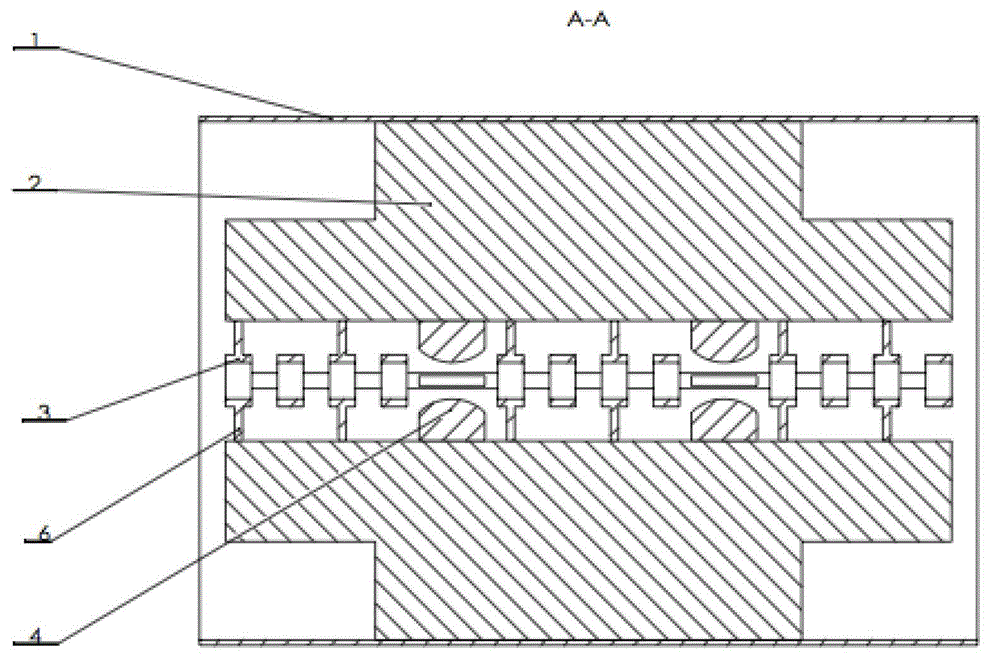High-frequency electric focusing high-gradient ion accelerator
An ion acceleration and high-frequency electric technology, which is applied in the field of nuclear energy, can solve the problems of poor acceleration quality of high-current and high-intensity ion beams, high cost of components, and low acceleration efficiency, and achieves the effects of high beam quality, compact structure and high acceleration efficiency.
- Summary
- Abstract
- Description
- Claims
- Application Information
AI Technical Summary
Problems solved by technology
Method used
Image
Examples
Embodiment 1
[0032] Example 1: see figure 2 , image 3 , Figure 4 , a high-frequency electric focusing high-gradient ion acceleration device, including four T-shaped plates 2 perpendicular to each other in a vacuum chamber 1, and 12 drift tubes 3 are fixedly connected to the two through drift tube support rods 6. Between two T-shaped plates 2; 12 drift tubes 3 and the vacuum chamber 1 are on the same center line; the vertical high-frequency electric quadrupole lens 4 is arranged between the drift tubes 3 and is fixedly connected to two vertical Between the T-shaped plates 2 ; the horizontal high-frequency electric quadrupole lens 5 is arranged between the drift tubes 3 facing each other, and is fixedly connected between the two horizontal T-shaped plates 2 . The diameter of the vacuum chamber 1 is 0.3m, the length is 0.5m, and the thickness of the T-shaped plate is between 30mm, which needs to be determined according to the mechanical strength.
[0033] The degree of vacuum of the vac...
Embodiment 2
[0041] Example 2: see figure 2 , image 3 , Figure 4 , a high-frequency electric focusing high-gradient ion accelerator, the main structure of which is the same as that of Example 1. The difference is that the diameter of the vacuum chamber 1 is 1.5m, the length is 6m, and the thickness of the T-shaped plate is between 100mm.
[0042] The degree of vacuum of the vacuum chamber 1 is 10 -4 -10 -7 Pa.
[0043] See Figure 5 , the vertical high-frequency electric quadrupole lens 4 is a saddle-shaped protrusion in the middle, and the minimum aperture between the two protrusions is 4cm. The length of the vertical high-frequency electric quadrupole lens is 20cm-30cm, and the length increases with increases with increasing ion velocity.
[0044] See Figure 6 , the horizontal high-frequency electric quadrupole lens 5 is a concave saddle shape, and the maximum aperture between the two concaves is 6cm. The length of the horizontal high-frequency electric quadrupole lens is 20c...
Embodiment 3
[0048] Embodiment 3: see figure 2 , image 3 , Figure 4 , a high-frequency electric focusing high-gradient ion accelerator, the main structure of which is the same as that of Example 1. The difference is that the diameter of the vacuum chamber 1 is 1m, the length is 3m, and the thickness of the T-shaped plate is between 60mm, which needs to be determined according to the mechanical strength.
[0049] The degree of vacuum of the vacuum chamber 1 is 10 -4 -10 -7 Pa.
[0050] See Figure 5 , the vertical high-frequency electric quadrupole lens 4 is a saddle-shaped protrusion in the middle, and the minimum aperture between the two protrusions is 3cm. The length of the vertical high-frequency electric quadrupole lens is 5-15cm, and the length increases with increases with increasing ion velocity.
[0051] See Figure 6 , the horizontal high-frequency electric quadrupole lens 5 is a concave saddle shape, and the maximum aperture between the two concaves is 3cm. The length of...
PUM
 Login to View More
Login to View More Abstract
Description
Claims
Application Information
 Login to View More
Login to View More - R&D
- Intellectual Property
- Life Sciences
- Materials
- Tech Scout
- Unparalleled Data Quality
- Higher Quality Content
- 60% Fewer Hallucinations
Browse by: Latest US Patents, China's latest patents, Technical Efficacy Thesaurus, Application Domain, Technology Topic, Popular Technical Reports.
© 2025 PatSnap. All rights reserved.Legal|Privacy policy|Modern Slavery Act Transparency Statement|Sitemap|About US| Contact US: help@patsnap.com



